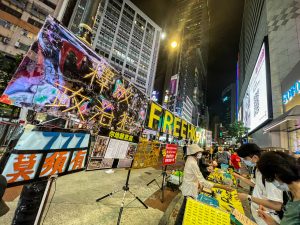Hong Kong artists are expressing growing concerns over the impact of the national security law on creativity and expression, in a city that was once touted as an Asian arts hub.
On March 17, Chief Executive Carrie Lam said authorities will be “on full alert” to ensure that museum exhibitions do not undermine national security, after pro-Beijing lawmaker Eunice Yung asked whether the government will allow artworks deemed to threaten security to be shown in the new West Kowloon Cultural District’s M+ Museum, which is set to open later this year.
“We have to respect the freedom of artistic expression,” Lam said. “I’m sure staff are able to tell what is freedom of artistic expression and whether certain pieces are really meant to incite hatred or destroy relations between two places and undermine national security.”
Days earlier, director Suhanya Raffel said the M+ museum of contemporary visual culture will uphold artist freedom and show artwork by Chinese dissident Ai Weiwei, as well as those referencing the 1989 Tiananmen Square crackdown. Originally set to open in 2017, the museum has seen its launch date pushed back several times, after issues related to construction work, fears over the security law, and the unexplained firing of the chief executive in charge of the cultural district project in September.
Lam’s comments came hours after an editorial by Chinese state-controlled paper Ta Kung Pao, which accused the government-run Hong Kong Arts Development Council (HKADC) of “funding black violence films” and giving about HK$15 million to “yellow” pro-democracy organizations it claims may have violated the national security law.
Two days before, the Hong Kong Film Critics Society also cancelled screenings of a documentary about the police siege of the Hong Kong Polytechnic University during the 2019 pro-democracy protests. The move followed accusations from pro-Beijing outlets that the documentary may threaten national security.
After the law was imposed last summer, the city reportedly saw an exodus of artists, with many saying they were making plans to leave. Bona, a local artist and scriptwriter working in the commercial film industry, confirmed this, saying that some of her colleagues have already moved to Taiwan, the United Kingdom, and elsewhere.
“Everyone has to choose what they want to do,” she said. “If you can keep a low profile and wait (for the situation to change), then you should. If you can’t, and you feel hopeless, you should go. We don’t want to see artists going to prison.”
While the latest developments hit hard, these political barriers are not new, she said. Hong Kong’s art industry has always faced immense pressure to cater to the mainland Chinese market. With funding being a key priority, the industry has also had to attract investors from China, which meant toeing the line politically, Bona added.
Elizabeth Briel, an artist who moved to Hong Kong five years ago and was previously based in Beijing, says local artists can learn from their counterparts in the mainland on ways to navigate the growing restrictions. The protest movements in 2014 and 2019 have fueled an explosion of creativity, and have led to the emergence of more subversive artwork in recent years, said Briel, who runs a studio in Hong Kong’s Creative Arts Center.
“I do think a lot of Hong Kong artists are scared,” said Briel, who previously ran an artist residency in a space called Creative Kowloon, before it was forced to close due to the pandemic and crackdowns on protests. “These are gray areas and red lines are being drawn. Nothing is fixed. It’s designed to keep you scared, to encourage self-censorship. I think we’re all monitoring what we’re doing and saying.”
According to Briel, there are archives of Hong Kong art being built overseas, and actions are being taken to preserve local culture. She also envisions many opportunities for Hong Kong artists to show work overseas.
Despite the growing challenges, Bona plans to stay in Hong Kong, and will continue trying to produce local films that make an impact. Artists can still explore political themes in their artwork, so long as they don’t directly touch on any red lines, she said.
“In Hong Kong, the hardware and software will keep changing,” Bona said. “Movies and visual art can record the ways the city is transforming. I think to have that context, it’s still important. In the future, we may need to look back on these records to see what Hong Kong was like now.”

































